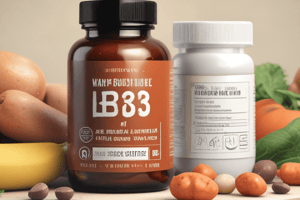Podcast
Questions and Answers
What is a result of a severe deficiency of thiamine?
What is a result of a severe deficiency of thiamine?
- Retarded growth
- Dermatitis
- Loss of appetite
- Beriberi (correct)
What is the main function of riboflavin in the body?
What is the main function of riboflavin in the body?
- Energy production
- Support of sight function (correct)
- Influencing sacharide metabolism
- Curing of skin diseases
Which vitamin is involved in oxidation-reduction reactions?
Which vitamin is involved in oxidation-reduction reactions?
- Thiamine
- Pantothenic Acid
- Niacin (correct)
- Riboflavin
What is the effect of a deficiency of pantothenic acid?
What is the effect of a deficiency of pantothenic acid?
What is a common source of thiamine?
What is a common source of thiamine?
Which vitamin is light sensitive?
Which vitamin is light sensitive?
What is a symptom of pyridoxine deficiency?
What is a symptom of pyridoxine deficiency?
What is the function of vitamin B12 in the body?
What is the function of vitamin B12 in the body?
What is the result of vitamin C deficiency?
What is the result of vitamin C deficiency?
What is the source of vitamin A?
What is the source of vitamin A?
What is the function of pyridoxal phosphate (PLP)?
What is the function of pyridoxal phosphate (PLP)?
What is the effect of vitamin B12 deficiency on the nervous system?
What is the effect of vitamin B12 deficiency on the nervous system?
What is the role of vitamin C in the body?
What is the role of vitamin C in the body?
What is the result of excessive vitamin C intake?
What is the result of excessive vitamin C intake?
What is the outcome of Thiamine (Vitamin B1) deficiency?
What is the outcome of Thiamine (Vitamin B1) deficiency?
What are the functions of Vitamin E?
What are the functions of Vitamin E?
Which of the following is a characteristic of Fat-Soluble Vitamins?
Which of the following is a characteristic of Fat-Soluble Vitamins?
What is the outcome of Vitamin D deficiency?
What is the outcome of Vitamin D deficiency?
Why are vitamins essential for our health?
Why are vitamins essential for our health?
What is the function of Thiamine Pyrophosphate (TPP)?
What is the function of Thiamine Pyrophosphate (TPP)?
What is the difference between Fat-Soluble and Water-Soluble Vitamins?
What is the difference between Fat-Soluble and Water-Soluble Vitamins?
What are the benefits of vitamins?
What are the benefits of vitamins?
Flashcards are hidden until you start studying
Study Notes
Coenzyme A
- Necessary for formation of glycogen, fatty acids, and steroid hormones
- Reduces stress, prevents tiredness
- Sources: whole grains, vegetables, eggs, liver, heart, yeast
Pyridoxine (Vitamin B6)
- Converted to coenzyme pyridoxal phosphate (PLP) which is required in transamination of amino acids and decarboxylation of carboxylic acids
- Deficiency leads to dermatitis, fatigue, and anemia
- Sources: meat, fish, liver, vegetables, cereals, yolk, legumes
- Functions: amino acid and protein metabolism, cure of anemia, formation of red blood cells
Cobalamin (Vitamin B12)
- Consists of four pyrrole rings with a Co2+ ion
- Functions as coenzyme for enzymes that transfer methyl groups and produce red blood cells
- Deficiency leads to pernicious anemia and nerve damage
- Sources: dairy products, meat, poultry, sea products
- Functions: formation of red blood cells, maintenance of neuro tissue, cure of neuro diseases and anemia
Ascorbic Acid (Vitamin C)
- Required for collagen synthesis
- Deficiency leads to weakened connective tissue, slow-healing wounds, and anemia
- Sources: Indian gooseberries, blueberries, citrus fruits, tomatoes, broccoli, red and green vegetables
- Functions: collagen synthesis, infection resistance, cure of cuts
Vitamin A
- Obtained from meats and beta-carotenes in plants
- Functions: influences saccharide metabolism, helps against tiredness
- Sources: meats and beta-carotenes in plants
Thiamine (Vitamin B1)
- Part of the coenzyme thiamine pyrophosphate (TPP)
- Deficiency leads to beriberi (fatigue, weight loss, and nerve degeneration)
- Sources: yeasts, cereals, rice, liver, legumes
- Functions: influences saccharide metabolism, helps against tiredness
Riboflavin (Vitamin B2)
- Part of the coenzymes flavin adenine dinucleotide (FAD) and flavin mononucleotide (FMN)
- Needed for good vision and healthy skin
- Sources: cereals, eggs, vegetables, dairy products, yeast, liver
- Functions: saccharide and lipid metabolism, curing of skin diseases, support of sight function
Niacin (Vitamin B3)
- Part of the coenzyme nicotinamide adenine dinucleotide (NAD+)
- Deficiency leads to dermatitis, muscle fatigue, and loss of appetite
- Sources: meats, rice, and whole grains
- Functions: involved in oxidation-reduction reactions
Pantothenic Acid (Vitamin B5)
- Part of coenzyme A needed for energy production
- Deficiency leads to fatigue, retarded growth, and anemia
- Sources: not specified
Vitamins
- Organic molecules with a wide variety of functions
- Cofactors for enzymatic reactions
- Essential, supplied in the diet
- Two distinct types: Fat-soluble (A, D, E, K) and Water-soluble (B-complex, C)
- Functions: improve immunity, prevent illnesses, slower aging
Fat-Soluble Vitamins
- A, D, E, and K
- Soluble in lipids, not in aqueous solutions
- Stored in the body
- Functions: vision, bone formation, antioxidants, and blood clotting
Studying That Suits You
Use AI to generate personalized quizzes and flashcards to suit your learning preferences.




